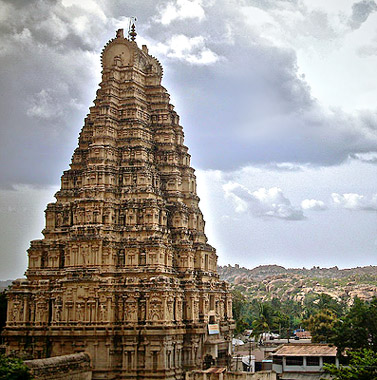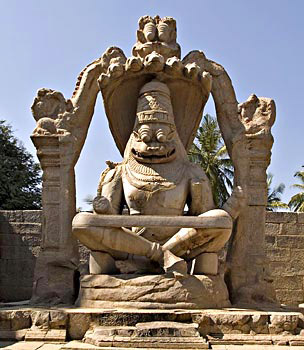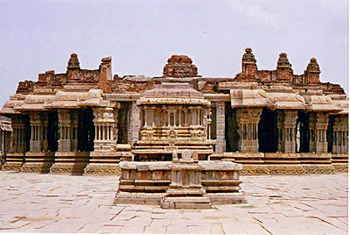The city of Vijayanagara is the representation of the socio cultural and religious bend of mind of the inhabitants. Moreover, the scattered remnants of the architectural constructions of the city stand evidences of the penchant for art and culture of the then populace.
Before the establishment of the Vijayanagara kingdom, in the second quarter of the fourteenth century AD, and the selection of the site south of the river Tungabhadra as its capital, Hampi was a small and fairly insignificant village. No doubt, this site was already a Saivite tirtha of local importance with a temple to god Virupaksa, a form of Siva, existing from at least the twelfth century AD onwards. There are epigraphical and literary references, dating from this period to `Hampe-Virupaksa`. That this area was also associated with Kiskindha of the Ramayana, at least from the eleventh century AD onwards, is indicated by inscriptional evidence. However, the site rose to significance only with the founding of the Vijayanagara state, of which it was the capital for about two hundred years till AD 1565. Following the disastrous battle of Talikota, the sack of the city and the shifting of the capital further south, the site once more sank into comparative insignificance.
The Vijayanagara city and its suburbs grew gradually from the mid-fourteenth century till AD 1565. Its evolution in the fourteenth and early fifteenth centuries, though gradual, was nevertheless remarkable. After about a century of the foundation of the kingdom, Vijayanagara had become a splendid city. When the envoy of the ruler of Heart, Abdur Razzak visited Vijayanagara in AD 1443 during the reign of Devaraya II, the city earned enormous appraisal.
 Prior to the founding of the Vijayanagara kingdom this site was a local Saivite pilgrimage spot. It comprised of a cluster of fairly small temples on the south bank of the river Tungabhadra, in the area more or less of the present village of Hampi, and on Hemakuta hill. Some of these shrines can be stylistically assigned as far back as the ninth-tenth centuries AD. The most important of these is the temple of god Virupaksa. The continued significance of this site as a religious centre till the early fourteenth century is revealed by the early fourteenth century foundational inscription in one of the temples on Hemakuta hill.
Prior to the founding of the Vijayanagara kingdom this site was a local Saivite pilgrimage spot. It comprised of a cluster of fairly small temples on the south bank of the river Tungabhadra, in the area more or less of the present village of Hampi, and on Hemakuta hill. Some of these shrines can be stylistically assigned as far back as the ninth-tenth centuries AD. The most important of these is the temple of god Virupaksa. The continued significance of this site as a religious centre till the early fourteenth century is revealed by the early fourteenth century foundational inscription in one of the temples on Hemakuta hill.
Harihara I (AD 1336-1356) of the Sarigama dynasty was the first ruler of the Vijayanagara kingdom. As per a damaged inscription, dated AD 1349, found in Anegondi, it is assumed that Harihara I ruled from Anegondi, on the north bank of the Tungabhadra River. The shift of the capital to the site south of the river and the laying of the foundation of the city were probably done during the reign of the second monarch, Bukka I (AD 1356-77). The establishment of the Muslim Bahmani kingdom in the upper Deccan and the commencement of the warfare that was to become endemic between the two kingdoms was possibly the reason for this transfer of headquarters.
The city during the period of Bukka I was quite small. While the area around the Virupaksa temple and the Hemakuta hill must have remained the ritual centre of the site, the administrative-military headquarters was located further south. It has also been presumed that the inner-most line of fortifications, that is, the one around the `royal centre` was constructed at this time and that the `royal centre` was the city of Bukka I. The `royal centre` saw the great expansion during the time of Harihara II, the successor of Bukka I, as the `urban core` of the city began to accommodate the increasing population of the capital.
The earliest dated temples of the Vijayanagara period at the site are from the reign of Harihara II. The city has a number of temple constructions prove that during the reign of the rulers the religious beliefs were intact among the people of this region. The earliest inscription referring to the building of a religious structure at the site is dated AD 1379 and it mentions the construction by a private individual of a `mandapa` for god  Narasimha i.e. in the temple of Narasirmha. This temple is situated on the south bank of the river, but at a distance to the east of the cluster of Shaivite shrines in and around the Virupaksa temple and the Hemakuta group. Another record of AD 1400 refers to the donation of a water pond to this deity. Evidently, it was a shrine of some importance in the late fourteenth century, and perhaps, was the earliest Vaishnava temple at the site. An inscription of AD 1386 reveals the contribution of a Siva temple by a customs official near that of Narasimha. With a Shaiva shrine and a Vaihsnava temple in close proximity to each other, the original religious area around the Virupaksa temple and Hemakuta hill still continued as a hub of religious activity. Later, in AD 1398, a small temple to god Virupaksa was erected on the southern end of Hemakuta hill by two Brahmin brothers.
Narasimha i.e. in the temple of Narasirmha. This temple is situated on the south bank of the river, but at a distance to the east of the cluster of Shaivite shrines in and around the Virupaksa temple and the Hemakuta group. Another record of AD 1400 refers to the donation of a water pond to this deity. Evidently, it was a shrine of some importance in the late fourteenth century, and perhaps, was the earliest Vaishnava temple at the site. An inscription of AD 1386 reveals the contribution of a Siva temple by a customs official near that of Narasimha. With a Shaiva shrine and a Vaihsnava temple in close proximity to each other, the original religious area around the Virupaksa temple and Hemakuta hill still continued as a hub of religious activity. Later, in AD 1398, a small temple to god Virupaksa was erected on the southern end of Hemakuta hill by two Brahmin brothers.
The fairly wide area covered by the five distinct temples reveal the spread of the city as it grew steadily in the last quarter of the fourteenth century. While the pre-Vijayanagara temples at the site are all of Saiva affiliation, these five are more representative in their affiliation: three are Saiva, one is Vaishnava and one Jain. This highlights the fact that before the end of the fourteenth century, although Shaivism was still dominant, the site had been transformed from a Shaivite tirtha or place of pilgrimage. The city incorporated varied groups of people with different sectarian affiliations.
Towards the end of the reign of Harihara II, in AD 1402, General Irugappa built another Jaina temple. This one is in Anegondi, indicating that Anegondi still continued to have some significance even after the shift of the headquarters south of the river, although this is the only dated Vijayanagara period temple in Anegondi. Evidently this place gradually sank into comparative obscurity, serving merely as another suburb of Vijayanagara city.
From the reign of Devaraya I there are no other dated structures at the site; except for a roofed well, erected at a distance from the city proper in what is the present-day village of Malapannagudi. Much of the layout of the city was completed during the reign of Devaraya II (1424-1446), except for certain suburbs and large temple complexes in them. The inclusion of persons belonging to diverse creeds in the military and civil life of the city appears to have been the conscious policy of this sovereign, who was the greatest ruler of the Sarigama line. The Jain community was favoured, as is revealed through the king`s construction of a temple for the worship of the Tirthankara Parsvanatha in AD 1426.
Devaraya II also initiated the practice of employing Muslims in the Vijayanagara army. Besides the Muslims serving in the military, who became residents of the city, Muslim envoys and traders also visited the city. The presence of Muslim presence is not only from literary and epigraphical sources, but also from the monumental data of a Muslim quarter in the city, in the north-eastern end of the `urban core`.
 After Devaraya II, there was little further development in the city during the Sangama period. Of the reign of king Mallikarjuna (AD 1446-1465) there is only one monument that can be identified by inscriptions. The lack of development of Vijayanagara city under the latter two rulers reflects the political decline of the Vijayanagara kingdom under them. Even during the short period of the second dynasty, the Saluva kings (AD 1485-1505), the city witnessed little change. The only development may have been the construction of the core of the great Vitthala temple.
After Devaraya II, there was little further development in the city during the Sangama period. Of the reign of king Mallikarjuna (AD 1446-1465) there is only one monument that can be identified by inscriptions. The lack of development of Vijayanagara city under the latter two rulers reflects the political decline of the Vijayanagara kingdom under them. Even during the short period of the second dynasty, the Saluva kings (AD 1485-1505), the city witnessed little change. The only development may have been the construction of the core of the great Vitthala temple.
The development and expansion of the city was resumed after the enthronement of the Tuluva or third dynasty. There is no evidence of any constructional activity of the first Tujuva king, Vira Narasimha (AD 1505-1509) but his successor, Krisnadevaraya (AD 1509-1529), revitalized the city. He was not only the most successful of the Tuluva line but was also the greatest among the Vijayanagara sovereigns. Besides being brilliant at military ventures, this monarch was also a generous patron of art and culture, and numerous additions were made by him in and around the capital city. On the occasion of his coronation, Krisnadevaraya had donated generously to the Virupaksa temple. With the construction of the `maharangamandapa` in the temple, the king introduced new architectural trends in Vijayanagara architecture, such as the `composite-pillar`. The Virupaksa temple, which is of pre-Vijayanagara origin, had already seen a fair amount of expansion in the fifteenth century, but during the sixteenth century it witnessed much constructional activity, transforming it into an enormous temple complex.
Besides constructional activities within the city proper, Krisnadevaraya also built a number of new suburbs to the south of the city. The township of Nagaladevlpura (the modern Nagenahalli) was named after the king`s mother. Tirumaladevi-ammana-pattana (located in present-day Hospet) was a suburb built in the name of the principal queen and Sale-Tirumala-maharaya-pura (now called Anantasayanagudi) was built in AD 1524 in honour of the king`s son, prince Tirumala.
During the reign of Achyutaraya, the half-brother and successor of Krisnadevaraya, certain significant additions were made within the Vitthala complex. Achyutaraya`s reign also saw the addition of two new localities, one of which was within the limits of the city proper in an area called Achyutarayapura. Here, a temple complex was erected for the god Tiruvehgajanatha in AD 1534 by the king`s brother-in-law and Prime Minister, Hiriya Tirumalaraja, and directly south of the city was built the suburban area of Varadadevi-ammana-pattana, named after the queen of Achyutaraya, where a large temple to god Raghunatha was built.
During the reign of the last of the Tuluvas, Sadasiva (AD 1542-1567), the maximum development was in Vitthalapura. The Vitthala temple became the greatest centre of religious activity in the city, a fact reflected in the constructional work undertaken both within and around the Vitthala complex. During the period of Sadasiva the development of the city was perceived not only in Vitthalapura but also in Krisnapura.
The splendid city of Vijayanagara, which over a period of two hundred odd years, had expanded from a small pilgrimage centre to an enormous capital city with many suburbs. The city served as the military, administrative and religious heart of a large kingdom, saw a dramatic downfall. After the disastrous defeat of the Vijayanagara forces in the battle of Talikota in AD 1565, the capital was sacked. Although the city was not completely destroyed, it could never recover its former glory. The attempt by Tirumala, the first ruler of the Aravidu dynasty, to restore it as a capital failed and the site soon fell into ruins.



















